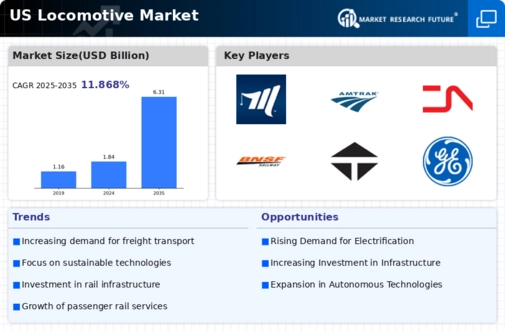The locomotive market in the US is characterized by a competitive landscape that is increasingly shaped by technological advancements and sustainability initiatives. Key players such as Union Pacific Railroad (US), BNSF Railway (US), and Norfolk Southern Railway (US) are actively pursuing strategies that emphasize innovation and operational efficiency. Union Pacific Railroad (US) has focused on enhancing its digital capabilities, which appears to be a response to the growing demand for data-driven decision-making in logistics. BNSF Railway (US), on the other hand, has been investing in infrastructure improvements to bolster its service reliability, while Norfolk Southern Railway (US) is concentrating on expanding its intermodal services, which suggests a strategic pivot towards more integrated transportation solutions. Collectively, these strategies indicate a competitive environment that is not only focused on traditional operational metrics but also on adapting to evolving market demands.
In terms of business tactics, companies are increasingly localizing manufacturing and optimizing their supply chains to enhance responsiveness and reduce costs. The market structure is moderately fragmented, with several key players exerting considerable influence over pricing and service standards. This fragmentation allows for a variety of operational models, which can lead to both competition and collaboration among firms. The collective influence of these major players shapes the market dynamics, as they vie for market share while also exploring partnerships that can enhance their service offerings.
In November 2025, Union Pacific Railroad (US) announced a partnership with a leading technology firm to develop advanced predictive analytics tools aimed at improving operational efficiency. This strategic move is likely to enhance Union Pacific's ability to anticipate maintenance needs and optimize train schedules, thereby reducing downtime and increasing overall productivity. The integration of such technology could position Union Pacific as a leader in operational excellence within the industry.
In October 2025, BNSF Railway (US) unveiled a new sustainability initiative focused on reducing greenhouse gas emissions by 30% by 2030. This initiative underscores BNSF's commitment to environmental stewardship and aligns with broader industry trends towards sustainability. By investing in cleaner technologies and practices, BNSF is not only addressing regulatory pressures but also appealing to a growing segment of environmentally conscious customers.
In September 2025, Norfolk Southern Railway (US) expanded its intermodal service offerings by launching a new route connecting key logistics hubs across the Midwest. This expansion is indicative of Norfolk Southern's strategy to capitalize on the increasing demand for intermodal transportation solutions, which are often more efficient and environmentally friendly than traditional freight methods. By enhancing its service portfolio, Norfolk Southern is likely to attract new customers and strengthen its competitive position.
As of December 2025, the locomotive market is witnessing a pronounced shift towards digitalization, sustainability, and the integration of artificial intelligence (AI) in operations. Strategic alliances are becoming increasingly important, as companies recognize the value of collaboration in enhancing service offerings and operational capabilities. The competitive differentiation is evolving from a focus on price to one that prioritizes innovation, technology, and supply chain reliability. This shift suggests that companies that can effectively leverage technology and sustainability will likely emerge as leaders in the market.


















Leave a Comment